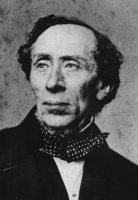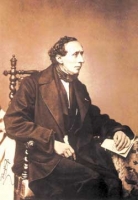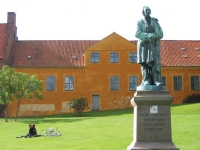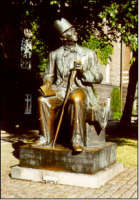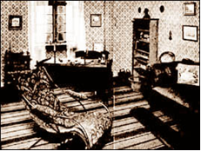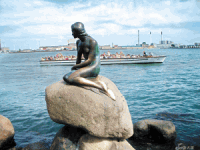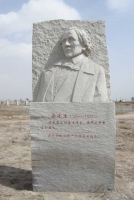|
閱讀安徒生 Hans Christian Andersen在小说之家的作品!!! |
安徒生終生未成傢室,1875年8月4日病逝於朋友——商人麥爾喬傢中。
安徒生文學生涯始於1822年。早期主要撰寫詩歌和劇本。進入大學後,創作日趨成熟。曾發表遊記和歌舞喜劇,出版詩集和詩劇。1833年出版長篇小說《即興詩人》,為他贏得國際聲譽,是他成人文學的代表作。
“為了爭取未來的一代”,安徒生决定給孩子寫童話,出版了《講給孩子們聽的故事》。此後數年,每年聖誕節都出版一本這樣的童話集。其後又不斷發表新作,直到1872年因患癌癥纔逐漸擱筆。近40年間,共計寫了童話168篇。
安徒生童話具有獨特的藝術風格:即詩意的美和喜劇性的幽默。前者為主導風格,多體現在歌頌性的童話中,後者多體現在諷刺性的童話中。
安徒生的創作可分早、中、晚三個時期。早期童話多充滿綺麗的幻想、樂觀的精神,體現現實主義和浪漫主義相結合的特點。代表作有《打火匣》、《小意達的花兒》、《拇指姑娘》、《海的女兒》、《野天鵝》、《醜小鴨》等。中期童話,幻想成分減弱,現實成分相對增強。在鞭撻醜惡、歌頌善良中,表現了對美好生活的執着追求,也流露了缺乏信心的憂鬱情緒。代表作有《賣火柴的小女孩》、《白雪皇后》、《影子》、《一滴水》、《母親的故事》、《演木偶戲的人》等。晚期童話比中期更加面對現實,着力描寫底層民衆的悲苦命運,揭露社會生活的陰冷、黑暗和人間的不平。作品基調低沉。代表作有《柳樹下的夢》、《她是一個廢物》、《單身漢的睡帽》、《幸運的貝兒》等。
安徒生年表
1805年4月2日出生於丹麥費恩島奧登塞小鎮。
1816年11歲時父親過世。
1819年14歲時獨自離傢到哥本哈根,尋求創作機會。
1822 年8月發表作品《嘗試集》,含詩劇及故事共三篇。此集子因其出身寒微而無出版機會,但已引起文化界某些人士的註意。10月,進入中等教會學校補習文化,共讀六年,對其教育方式感到痛苦不已;不過這六年中大量閱讀名傢作品,也練習創作詩篇、歌劇。1827年,離開學校回到哥本哈根。發表詩歌,受到上流社會評論傢稱贊,鼓起安徒生對寫作的信心。
1829年,寫出長篇幻想遊記《阿馬格島漫遊記》出版,第一版銷售一空。出版商立刻以優厚條件買下第二版,安徒生因此從饑餓的壓迫中解脫。喜劇《在尼古拉耶夫塔上的愛情》在皇傢歌劇院上演。同年也出版第一本詩集。
1830年,初戀失敗。開始旅行;第二本詩集出版。
1831-1834年,戀愛再度失敗,遭逢母喪,不久出版長篇自傳體小說《即興詩人》。
1835 年30歲時開始寫童話,出版第一本童話集,僅61頁的小册子,內含《打火匣》、《小剋勞斯和大剋勞斯》、《豌豆上的公主》、《小意達的花兒》共四篇。作品並未獲得一致好評,甚至有人認為他沒有寫童話的天份,建議他放棄,但安徒生說:“這纔是我不朽的工作呢!”
1844年,寫出自傳性作品《醜小鴨》。
1846年,寫出《賣火柴的小女孩》。
1970年出版晚期最長一篇作品《幸運的貝兒》,共七萬餘字,是以他自己的生活感受為基礎寫成的,但不完全是自傳。
1867年,被故鄉奧登塞選為榮譽市民。
1875年8月4日上午11時,因肝癌逝世於朋友的鄉間別墅。喪禮備極哀榮,享年70歲。
During his lifetime he was acclaimed for having delighted children worldwide, and was feted by royalty. His poetry and stories have been translated into more than 150 languages. They have inspired motion pictures, plays, ballets, and animated films.
Childhood
Hans Christian Andersen was born in the town of Odense, Denmark, on Tuesday, April 2, 1805. "Hans" and "Christian" are traditional Danish names.
Andersen's father considered himself related to nobility. According to scholars at the Hans Christian Andersen Center,[citation needed] his paternal grandmother had told his father that their family had in the past belonged to a higher social class, but investigations prove these stories unfounded. The family apparently was affiliated with Danish royalty, but through employment or trade. Today, speculation persists that Andersen may have been an illegitimate son of the royal family. Whatever the reason, King Frederick VI took a personal interest in him as a youth and paid for a part of his education.[citation needed] According to writer Rolf Dorset, Andersen's ancestry remains indeterminate. Hans Christian was forced to support himself. He worked as a weaver's apprentice and later, for a tailor. At 14, he moved to Copenhagen to seek employment as an actor. Having an excellent soprano voice, he was accepted into the Royal Danish Theatre, but his voice soon changed. A colleague at the theatre told him that he considered Andersen a poet. Taking the suggestion seriously, he began to focus on writing.
Andersen had a half-sister, Karen Marie, with whom he managed to speak on only a few occasions before her death.[citation needed]Jonas Collin, who, following a chance encounter with Andersen, immediately felt a great affection for him, sent him to a grammar school in Slagelse, covering all his expenses. Andersen had already published his first story, The Ghost at Palnatoke's Grave in 1822. Though not a keen student, he also attended school at Elsinore, until 1827.
He later said his years in school were the darkest and most bitter of his life. At one school, he lived at his schoolmaster's home. There he was abused in order "to improve his character", he was told. He felt alienated from his classmates, being older than most of them. Considered unattractive, he suffered also from dyslexia [citation needed]. He later said the faculty had discouraged him from writing in general, causing him to enter a state of depression.
Early works
In 1829, Andersen enjoyed considerable success with a short story titled "A Journey on Foot from Holmen's Canal to the East Point of Amager". He also published a comedy and a collection of poems that season. Though he made little progress writing and publishing immediately thereafter, in 1833 he received a small traveling grant from the King, enabling him to set out on the first of his many journeys through Europe. At Jura, near Le Locle, Switzerland, he wrote the story, "Agnete and the Merman". He spent an evening in the Italian seaside village of Sestri Levante the same year, inspiring the name, The Bay of Fables. (See Voyagefever.com — an annual festival celebrates it). In October, 1834, he arrived in Rome. Andersen's first novel, "The Improvisatore", was published at the beginning of 1835, becoming an instant success. During these traveling years, Hans Christian Andersen lived in an apartment at number 20, Nyhavn, Copenhagen. There, a memorial plaque was unveiled on May 8, 1835, a gift by Peter Schannong.
Fairy Tales
Paper chimney sweep cut by AndersenIt was during 1835 that Andersen published the first installment of his immortal Fairy Tales (Danish: Eventyr). More stories, completing the first volume, were published in 1836 and 1837. The quality of these stories was not immediately recognized, and they sold poorly. At the same time, Andersen enjoyed more success with two novels: O.T. (1836) and Only a Fiddler. His Specialty book that is still known today was the Ugly Duckling (1837).
Jeg er en Skandinav
After a visit to Sweden in 1837, Andersen became inspired by Scandinavism and committed himself to writing a poem to convey his feeling of relatedness between the Swedes, the Danes and the Norwegians. It was in July 1839 during a visit to the island of Funen that Andersen first wrote the text of his poem Jeg er en Skandinav (I am a Scandinavian). Andersen designed the poem to capture "the beauty of the Nordic spirit, the way the three sister nations have gradually grown together" as part of a Scandinavian national anthem. Composer Otto Lindblad set the poem to music and the composition was published in January 1840. Its popularity peaked in 1845, after which it was seldom sung.
Travelogues
In 1851, he published to wide acclaim In Sweden, a volume of travel sketches. A keen traveler, Andersen published several other long travelogues: Shadow Pictures of a Journey to the Harz, Swiss Saxony, etc. etc. in the Summer of 1831 (A Poet's Bazaar (560), In Spain , and A Visit to Portugal in 1866 (The latter describes his visit with his Portuguese friends Jorge and Jose O'Neill, who were his fellows in the mid 1820s while living in Copenhagen.) In his travelogues, Andersen took heed of some of the contemporary conventions about travel writing; but always developed the genre to suit his own purposes. Each of his travelogues combines documentary and descriptive accounts of the sights he saw with more philosophical excurses on topics such as being an author, immortality, and the nature of fiction in the literary travel report. Some of the travelogues, such as In Sweden, even contain fairy-tales.
In the 1840s Andersen's attention returned to the stage, however with no great success at all. His true genius was however proved in the miscellany the Picture-Book without Pictures (1840). The fame of his Fairy Tales had grown steadily; a second series began in 1838 and a third in 1845. Andersen was now celebrated throughout Europe, although his native Denmark still showed some resistance to his pretensions. Between 1845 and 1864, H. C. Andersen lived in 67, Nyhavn, Copenhagen, where a memorial plaque is placed.
Meetings with Dickens
In June 1847, Andersen paid his first visit to England and enjoyed a triumphal social success during the summer. The Countess of Blessington invited him to her parties where intellectual and famous people could meet, and it was at one party that he met Charles Dickens for the first time. They shook hands and walked to the veranda which was of much joy to Andersen. He wrote in his diary "We had come to the veranda, I was so happy to see and speak to England's now living writer, whom I love the most."
Ten years later, Andersen visited England, primarily to visit Dickens. He stayed at Dickens' home for five weeks, oblivious to Dickens' increasingly blatant hints for him to leave. Dickens' daughter said of Andersen, "He was a bony bore, and stayed on and on." Shortly after Andersen left, Dickens published David Copperfield, featuring the obsequious Uriah Heep, who is said to have been modeled on Andersen.[citation needed]
Love life
Andersen often fell in love with unattainable women and many of his stories are interpreted as references to his sexual grief. The most famous of these was the opera soprano Jenny Lind. One of his stories, "The Nightingale", was a written expression of his passion for Lind, and became the inspiration for her nickname, the "Swedish Nightingale". Andersen was often shy around women and had extreme difficulty in proposing to Lind. When Lind was boarding a train to take her to an opera concert, Andersen gave Lind a letter of proposal. Her feelings towards him were not the same; she saw him as a brother, writing to him in 1844 "farewell... God bless and protect my brother is the sincere wish of his affectionate sister, Jenny." A girl named Riborg Voigt was the unrequited love of Andersen's youth. A small pouch containing a long letter from Riborg was found on Andersen's chest when he died. At one point he wrote in his diary: "Almighty God, thee only have I; thou steerest my fate, I must give myself up to thee! Give me a livelihood! Give me a bride! My blood wants love, as my heart does!" Other disappointments in love included Sophie Ørsted, the daughter of the physicist Hans Christian Ørsted, and Louise Collin, the youngest daughter of his benefactor Jonas Collin.
Just as with his interest in women, Andersen would become attracted to nonreciprocating men. For example, Andersen wrote to Edvard Collin,: "I languish for you as for a pretty Calabrian wench... my sentiments for you are those of a woman. The femininity of my nature and our friendship must remain a mystery." Collin, who did not prefer men, wrote in his own memoir: "I found myself unable to respond to this love, and this caused the author much suffering." Likewise, the infatuations of the author for the Danish dancer Harald Scharff and Carl Alexander, the young hereditary duke of Saxe-Weimar-Eisenach, did not result in any relationships.
In recent times some literary studies have speculated about the homoerotic camouflage in Andersen's works.
In Andersen's early life, his private journal records his refusal to have sexual relations.
Death
In the spring of 1872, Andersen fell out of bed and was severely hurt. He never fully recovered, but he lived until August 4, 1875, dying of insidious causes in a house called Rolighed (literally: calmness), near Copenhagen, the home of his close friends Moritz Melchior, a banker, and his wife. Shortly before his death, he had consulted a composer about the music for his funeral, saying: "Most of the people who will walk after me will be children, so make the beat keep time with little steps." His body was interred in the Assistens Kirkegård in the Nørrebro area of Copenhagen.
At the time of his death, he was an internationally renowned and treasured artist. He received a stipend from the Danish Government as a "national treasure". Before his death, steps were already underway to erect the large statue in his honor, which was completed and is prominently placed at the town hall square in Copenhagen.
Legacy
In the English-speaking world, stories such as "Thumbelina", "The Snow Queen", "The Ugly Duckling", "The Little Mermaid", "The Emperor's New Clothes", and "The Princess and the Pea" remain popular and are widely read. "The Emperor's New Clothes" and "The Ugly Duckling" have both passed into the English language as well-known expressions.
In the Copenhagen harbor there is a statue of The Little Mermaid, placed in honor of Hans Christian Andersen. April 2, Andersen's birthday, is celebrated as International Children's Book Day. The year 2005 was the bicentenary of Andersen's birth and his life and work was celebrated around the world.
In the United States, statues of Hans Christian Andersen may be found in Central Park, New York, and in Solvang, California. The Library of Congress Rare Book and Special Collections Division holds a unique collection of Andersen materials bequeathed by the Danish-American actor Jean Hersholt. Of particular note is an original scrapbook Andersen prepared for the young Jonas Drewsen.
The city of Bratislava, Slovakia features a statue of Hans Christian Andersen in memory of his visit in 1841.
In the city of Lublin, Poland is the Puppet & Actor Theatre of Hans Christian Andersen.
A $13-million theme park based on Andersen's tales and life opened in Shanghai at the end of 2006. Multi-media games as well as all kinds of cultural contests related to the fairy tales are available to visitors. He was chosen as the star of the park because he is a "nice, hardworking person who was not afraid of poverty", Shanghai Gujin Investment general manager Zhai Shiqiang was quoted by the AFP news agency as saying.
Fairy tales
Some of his most famous fairy tales include:
The Angel (1843) University of Southern Denmark (Danish)
The Bell (1845) University of Southern Denmark (Danish)
The Emperor's New Clothes (1837) University of Southern Denmark
The Galoshes of Fortune (1838) "Lykkens Kalosker"
The Fir Tree (1844) University of Southern Denmark (Danish)
The Happy Family (1847)
The Ice Maiden (1861) "Iisjomfruen"
It's Quite True! (1852) University of Southern Denmark (Danish)
The Little Match Girl (1848) University of Southern Denmark
The Little Mermaid (1836) University of Southern Denmark (Danish)
Little Tuck (1847) University of Southern Denmark (Danish)
The Nightingale (1844) University of Southern Denmark (Danish)
The Old House (1847) University of Southern Denmark (Danish)
Sandman (1841) University of Southern Denmark (Danish)
The Princess and the Pea (1835; also known as The Real Princess) University of Southern Denmark (Danish)
Several Things (1837) University of Southern Denmark (Danish)
The Red Shoes (1845) University of Southern Denmark (Danish)
The Shadow (1847) University of Southern Denmark (Danish)
The Shepherdess and the Chimney Sweep (1845)
The Snow Queen (1844) University of Southern Denmark (Danish)
The Steadfast Tin Soldier (1838) University of Southern Denmark (Danish)
The Story of a Mother (1847) University of Southern Denmark (Danish)
The Swineherd (1841) University of Southern Denmark (Danish)
Thumbelina (1835) University of Southern Denmark (Danish)
The Tinderbox (1835) University of Southern Denmark (Danish)
The Ugly Duckling (1844) University of Southern Denmark (Danish)
The Wild Swans (1838) University of Southern Denmark (Danish)
